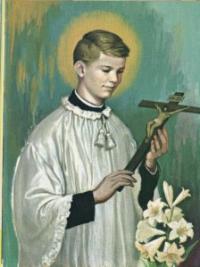
St Aloysius Gonzaga (1568 - 1591)
Feast day: 21 June
St Aloysius Gonzaga was the eldest of seven children of Ferrante, Marquis of Castiglione, who was of the junior branch of the Gonzaga family of Mantua. His mother was connected to the Della Rovere family which produced two Popes. His father had been offered a position by Henry VIII of England but he preferred the Spanish court. His mother was lady in waiting to Elizabeth wife of Philip II. As the eldest son he would inherit the title, so from a very early age he was given a military training. He was also educated in languages and the arts. At the age of eight he was sent to the court of Francesco de Medici, where he developed a disease of the kidneys which would trouble him through his short life. During his illness he spent much of his time reading the lives of thesaints and in prayer. He is said to have taken a vow of chastity at the age of nine. In 1579 he was sent to his godfather, the Duke of Mantua, where he was shocked by the violent and frivolous lifestyle there.
He returned to Castiglione where he met the reforming Archbishop of Milan, Charles Borromeo, and received his first communion from him. He then heard about the Jesuit missionaries in India and felt he wanted to be a missionary himself. He started teaching catechism to young boys in Castiglione in the summer. He began to visit the Capuchins and Barnabites and to lead an ascetic lifestyle. He briefly spent time in the Spanish court as a page but then decided he wanted to join the young order of the Society of Jesus, having had a Jesuit confessor in Madrid. His mother agreed but his father furiously forbade it.
The family returned to Italy and, discovering that Aloysius was not going to change his mind, they tried to persuade him to be a secular priest and offered to arrange a bishopric for him. If he became a Jesuit he would have to renounce his inheritance and status in society. Aloysius persisted, gave up all his rights and in 1585 he was received into the Jesuit novitiate. In addition to his kidney complaint Aloysius suffered many other ailments; for this reason he was sent to Rome rather than Milan. He took the vows of poverty, chastity and obedience and having entered minor orders started studying for his ordination.
In 1591 a plague began in Rome. St Ignatius and his companions had devoted time to looking after the sick and this tradition was continued by their successors who opened a hospital. Aloysius volunteered to work there. He was put on a ward where there were no plague victims, as the Order was afraid of losing him. It turned out that a man there had the plague and Aloysius became infected. He made a brief recovery but later he told people he would die in the octave of Corpus Christi. On June 21 he insisted that he would die that evening. His confessor, St Roberty Bellarmine, gave him the Last Rites and Aloysius died just before midnight. He was twenty-three years old. His remains now lie in St Ignazio church in Rome.
It was said that Aloysius to preserve his chastity would never look at a woman. His discomfort with his sexuality is disquieting; however we have to realise that a lot of his family and the society around him were quite dissolute, and church teaching on sexuality as gift has only developed comparatively recently. We can admire his steadfast resolve to give up everything to serve Christ and his bravery in nursing the sick when he suffered so greatly himself. St Aloysius is patron, especially, of youth.
St Aloysius Gonzaga, pray for us.